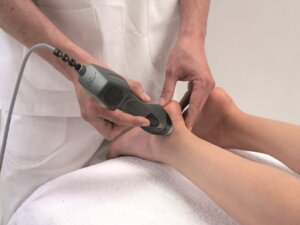The Business of Patient Priorities
Private practice and bookings
When Facebook blogging podiatrists write they cannot fit patients in, we decided to look at some patient management and flow conundrums. Debbie Delves and David Tollafield discuss funding, retention, NHS versus private practice, employment and fees. Maybe you are a podiatrist, and you have a viewpoint. If so, let ConsultingFootPain know, write a response, and join the conversation. Podiatrists are invited to reply to this discussion by filling in the response box below.
Recruitment and shortage – Debbie
I think there are several things. First of all, NHS access is increasingly hard post-Covid. Anything I say will probably be anecdotal here because I haven’t spoken to NHS colleagues. It’s worth having that conversation. There is also the national shortage of podiatrists that we’re all familiar with, and I believe the NHS has the same recruitment issues as in the private sector. So it’s about holes in the services, and it’s about funding.
An NHS Viewpoint – David
There is no doubt a misconception about the NHS and how it sees its own podiatric service delivery. Sarah, a Band 6 podiatrist, talked to ConsultingFootPain. Sarah emphasises the major difference between the NHS and the independent sector is that the department has to focus on risk across the spectrum of patients. The same patients are still seen as they always have, the young and elderly, but that focus is on risk-associated needs.
“We focus on moving on in the disease process, managing patients and giving them the best care. And again, it’s all about preventing these problems, preventing them from losing a limb, from losing a digit, from losing their life because of their poor health.” Sarah Twiss [i]
The NHS has always had categories, but triage and shrinkage now mean there is a focus. The shrinkage also affects home visits, although these are still carried out. In many ways, there is a difference between the independent sector and the NHS.
Neglect and patient priority – Debbie
However, the same recruitment issues exist in the NHS and the private sector. On top of this, the fabric of healthcare is under greater strain because people have been neglecting their feet a lot more than they did before, and problems have built up over those two years where they weren’t doing things. So people having foot health checks every four to six months haven’t had them for two years, and small problems became big problems, and therefore needed more treatment.
At the same time, people are more health aware, more fitness aware, and more on their feet, so it’s a combination of more patients wanting podiatry with less availability. So we have a trio of factors: funding essentially, patients failing to check their feet, so the problems have built up during the Covid period, and lastly, better health awareness is actually drawing them out of the public arena now.
Funding and retention
David
Between 2025 to 2030, there’s going to be at least a shortfall of 30% in NHS recruitment. Is this because of a lack of investment or a lack of podiatrists? It’s probably a bit of both. Recruitment plays a big part in employing the right people who need to grow and develop their careers. Secondly, there is the need for retention. Since time memorial, most graduates have to work their passage of right to advance by position availability and demonstrating worthiness. Up-skilling today requires investment, which depends on training budgets and the distribution of opportunity. With opportunity and a budget, progress can be curtailed. Secondly, and this is less transparent, the desire borne whilst at university to take on high-risk, wound management, minor surgery and MSK work can sometimes lead to disappointment. The graduate finds they have to wait and hope they can take on one of these roles, which may be filled by an existing Band 6 or 7. Band 7s are harder to come upon, so impatience can contribute to a decision to leave. Most graduates would have to put in at least 18 months to see a change in their role.
Recruitment – Debbie
I think, as far as private practice is concerned, we’re not particularly turning people away at the moment. Interestingly, I think ‘the turning people away problem’ may diminish over the next six months just because of what’s happening with the economy. We’ve got two chairs, and I’ve been looking at expanding and getting bigger premises. But then you have this expense of getting something fit for purpose and higher rents, and all the rest of it, balanced against the “can I recruit?” issue. But you can’t start recruiting until you’ve got somewhere; if you buy somewhere and can’t recruit, you can’t afford it. And it’s a real dilemma for people to make that jump.
Criticism – fair or foul? – David
Some podiatrists are turning people away when they shouldn’t be; they’re not working their practices in a way that’s either more efficient or intelligent. Is this a fair criticism? Many say it comes down to the right fee structure; what are your thoughts, Debbie?
The importance of fee structure – Debbie
The obvious thing is the fee. There are still people out there who are charging silly amounts and complaining that they’re overworked. You can see many people with routine care, at a low cost, and you have to see more people if you’re charging double the amount, plus you only need half the people. I mean, it’s a little bit more sophisticated than that. But on a very basic scale, if you’re charging £20, you’ll need double the amount of people to get £800 than you would if you’re charging £40, or if you’re charging £80, The fee is a big thing. People still get very hung up about charging a professional amount for a professional job, rather than valuing their work.
Gaining support in practice – David
But is it down to fee structure alone? I think podiatrists need support – coaching, for example, because it needs a change in mindset. It needs the ability to start valuing their profession, and valuing themselves and valuing their own time, and that’s quite a new concept for some. It’s interesting because it’s something that I almost learned in 1981 when I first set up. I set my fee at around £6.50 when most people charged £3.50. Some people have a natural business ability, and others must learn it. You can learn how to undertake business because it’s based on understanding how to employ people, the basis of overheads. I think that’s very important. You’ll go out of business if you don’t have your overheads covered. You’ve got to look around the marketplace to see what other people are charging because you want to be competitive. Still, if you’re introducing new techniques into your practice – which I think many people are – the MSK market is using extracorporeal shockwave treatment, for example. Low laser treatment is now really de rigueur for podiatry practice. Some want to introduce acupuncture to provide pain relief. It is essential that podiatry expedites all these methods of managing patients’ pain.
Fear of upping fees – Debbie
But I think knowing stuff, and implementing stuff are two different things. Many people know they should be charging more, but they’re scared. And it’s having the belief in your practice, the belief in yourself, and having support. I’m not here to promote any particular group, but there are lots of groups where you have peer support from other people because I think sometimes you do just need to take that leap, and sometimes having somebody holding your hand is useful and talking to other people who have done it, even though they were scared, and have reaped the benefits. I think that’s where things like the examples in your books are helpful because fear holds many people back rather than understanding.
Cyclical diary filling – David
It’s losing your clients that people worry about because there’s this mentality, I think, that’s been incorporated into practice, that you have to fill your diary. I believe you should always have spaces available for emergency patients, for new patients, because, every new patient you lose, will transpose to another practice where they pick that patient up potentially. So that’s lost business. I feel, in some ways, that’s what people are failing. Now, to have your regular customers, it’s a question whether you will step outside what people want. Or will you give them what you need to give them as a professional podiatrist? And, of course, we’re just about to step on the old trapdoor of the foot health practitioner, as well as the sort of C and C approach to podiatry, which does need to be completely reworked. I like to emphasise subjects such as corns and calluses, which should be promoted as secondary to our workload. The first thing that people might say is, “we deal with corns, calluses, hammer toes, and nails.” It’s not I have a problem with that. Absolutely not. That’s what we specialise in, but it’s how you market it. Diagnosis and assessment related to medical health are the key elements of our work. Skin is a major part, but then so is MSK. Core podiatry has, in my view, changed enormously.
(C&C is ‘cut and come again’)

Extracorporeal shockwave treatment for tendon pain
Finding solutions – Debbie
I was going to say we deal with feet, and those things you’ve just described happen on feet. But like you said – it’s about fixing and finding the solution. Patients don’t care that you’ve got extracorporeal shockwave therapy, low-level lasers, verruca needling, and things. They just want whatever is fixed, and one of the problems with patients regarding preventative care is that patients tend to be pain driven. There’s a big educational piece around patients that the dentist got just right 100 years ago about prevention that we struggle with in podiatry because we could prevent so many problems with gait analysis, biomechanics, good skincare, and good nail care. The stuff you’re just talking about, corns and calluses, are usually a symptom of something else. Still, if we’re professional practitioners, we shouldn’t be just firefighting and not actually dealing with the cause. You’ll get diaries that are chock a block full because you’re not actually discharging anyone. You’re not fixing anyone. How is that professional?

A need to cross boundaries from traditional to advanced?
Using lower-skilled people – David
The other solution is to actually employ people who can provide a service where you’ve got what I call maintenance care.
Foot Health Practitioners – Debbie
Some patients come to us and are in the older category. First of all, they don’t have the money, they don’t have insurance. And they have problems you can’t cure without much more intensive treatment, which is either a higher risk for them or, podiatry is outside their pocket. More and more practices are employing Foot Health Practitioners and podiatry assistants. It’s still not commonplace, and I think that some of the assurances that the Royal College have given around the way that FHPs will be trained – I can’t use the word ‘regulated,’ but supervised in the future. If those things come to pass, I think it will make people feel better about using FHPs. We have a split profession in terms of opinion on this matter. I don’t think we’re unusual, and I suspect dentists and nurses all had similar things. You still hear about healthcare assistants in doctor’s surgeries. Suddenly somebody will pop up on the news because they were a healthcare assistant who did something, right or wrong. I think the important thing for us is about – as it is for the dentists – differentiating qualifications, and knowing who it is, that’s doing what.
My practice went and did a talk for a homecare service last week. We were talking to these carers, and they said, “Oh, yes, my patient has a chiropodist come in,” I replied, “were they regulated chiropodists, or are they foot health practitioners?”
“Oh, I don’t know,” was the reply. I said, “Well, if they’re just having their toenails cut, and there’s not a lot going on, that might not be a problem anyway, but you need to know who it is doing it.” And that’s our big problem in the wide world: people don’t know who is doing what. My dentist will occasionally polish and scale and do the stuff his hygienist would usually do if time allows, but I’m very clear that that’s him doing it and not the hygienist. To be honest, the hygienist does a better job of it. I think there’s something in that as well. It’s about skill level.
David
As a manager, Debbie, do you have less face-to-face time with patients as you put time into training and supporting your staff?
In-house coaching – Debbie
For me, it’s about enabling my team. Coaching my team to be better, but also starting to help show them some of the things that I’m learning so they can recognise it in patients and be more helpful to their patients and more effective in their treatments.
Patient choice versus the best advice. – David
That’s all to do with being a good practitioner because if you can cut through that very early on, you might be able to plan patient management completely differently. We must accept that every patient that walks through the door needs a separate plan, even though we’re taught a blueprint. That’s the problem with leaving college. You leave college with literal ‘coat hangers.’ They haven’t got any substance hanging on them; they’ve only got the frame. Until you’ve been in practice, and someone like yourself comes along and says, “by the way, look, you’ve got to look at that patient differently,” it returns to a business model.
The other thing that you mentioned – and I think this is something we all struggle with – is that we know that we would like to treat patients with A, B or C, and the patients don’t want B and C; they want A – either because it’s cost neutral to them whereas B and C may in fact offer them the prevention, or it may offer them a correction or cure. And so, your sales technique has to creep in without bludgeoning the patient to a point where they feel they haven’t a choice. If you look at what the British Medical Association are on about general medical training, it’s all about – and I believe NICE have actually driven this for medication prescribing. We’ve heard about patient choice, but they’ve produced screeds for doctors on how to talk to patients, and it’s actually available. It’s a massive amount. And the irony is that I would reckon that the majority of podiatrists actually utilise that already because we are better at listening and have better people skills than the average GP.
Defining function – Debbie
One of the things you said right at the beginning was about what patients want. Do we do what patients want or give them what they need? I think that the skill of a good practitioner is to marry those things up. And like you’ve just said, always develop the conversation, so the patient goes on, “I want my corn gone,” but you need to take that higher so that they want the cause treated rather than just getting rid of their initial pain. That, I think, is a skill that, as you say, most of us already have, but we don’t almost realise we’re doing it. When we realise what we’re doing and how we’re doing it, we can optimise it. I wouldn’t have a problem with the change of use of the word ‘chiropody.’ Still, from a legal point of view, there’s no difference, and I think it adds to the confusion that’s already out there when some people use chiropody for routine care and podiatry for advanced care. It just adds to the confusion because there’s no clear definition.
So theoretically, I think that defining the function – and we know that the HCPC don’t want to define function – but defining the function of chiropody and allocating that to a specific function, I don’t have a problem with, but it needs to be done. It needs to be done properly rather than some people using the terms separately.
These were the personal thoughts of Debbie Delves and David Tollafield. Please add your own experience so readers can share ideas.
Reference
[i] Sarah Twiss in the NHS, taken from A Career in Podiatric Medicine. A Step in the Right Direction. Busypencilcase Communications. Section 2 – page23. Due for release in early 2023.
Thanks for reading ‘Where does patient blockage lie?’ an interview block produced by Consultingfootpain published by Busypencilcase Communications Est. 2015

Consultingfootpain is free to access with information for patients (footlocker) and podiatrists (clinical articles). New blogs are published monthly, and a newsfeed is needed to stay in touch. Just sign up.




Recent Comments